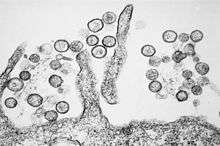Hantavirus hemorrhagic fever with renal syndrome
| Hantavirus | |
|---|---|
 | |
| Transmission electron micrograph of the Sin Nombre Hantavirus | |
| Virus classification | |
| Group: | Group V ((-)ssRNA) |
| Order: | Unassigned |
| Family: | Bunyaviridae |
| Genus: | Hantavirus |
| Type species | |
| Hantaan virus | |
| Species | |
|
Asama virus | |
Hantavirus hemorrhagic fever with renal syndrome (HFRS) is a group of clinically similar illnesses caused by species of hantaviruses from the family Bunyaviridae. It is also known as Korean hemorrhagic fever, epidemic hemorrhagic fever, and nephropathis epidemica. The species that cause HFRS include Hantaan River virus, Dobrava-Belgrade, Saaremaa, Seoul, Puumala and other hantaviruses. It is found in Europe, Asia, and Africa.[1] Of these species, Hantaan River virus and Dobrava-Belgrade virus cause the most severe form of the syndrome and have the highest morbidity rates.
Both hemorrhagic fever with renal syndrome (HFRS) and hantavirus pulmonary syndrome (HPS) appear to be immunopathologic, and inflammatory mediators are important in causing the clinical manifestations.
Signs and symptoms
Symptoms of HFRS usually develop within 1 to 2 weeks after exposure to infectious material, but in rare cases, they may take up to 8 weeks to develop. Initial symptoms begin suddenly and include intense headaches, back and abdominal pain, fever, chills, nausea, and blurred vision. Individuals may have flushing of the face, inflammation or redness of the eyes, or a rash. Later symptoms can include low blood pressure, acute shock, vascular leakage, and acute kidney failure, which can cause severe fluid overload.
The severity of the disease varies depending upon the virus causing the infection. Hantaan and Dobrava virus infections usually cause severe symptoms, while Seoul, Saaremaa, and Puumala virus infections are usually more moderate. Complete recovery can take weeks or months.[2]
The course of the illness can be split into five phases:
- Febrile phase
- Symptoms include redness of cheeks and nose, fever, chills, sweaty palms, diarrhea, malaise, headaches, nausea, abdominal and back pain, respiratory problems such as the ones common in the influenza virus, as well as gastro-intestinal problems. These symptoms normally occur for three to seven days and arise about two to three weeks after exposure.
- Hypotensive phase
- This occurs when the blood platelet levels drop and symptoms can lead to tachycardia and hypoxemia. This phase can last for 2 days.
- Oliguric phase
- This phase lasts for three to seven days and is characterised by the onset of renal failure and proteinuria.
- Diuretic phase
- This is characterized by diuresis of three to six litres per day, which can last for a couple of days up to weeks.
- Convalescent phase
- This is normally when recovery occurs and symptoms begin to improve.
This syndrome can also be fatal. In some cases, it has been known to cause permanent renal failure.[3]
Transmission
Transmission by aerosolized rodent excreta still remains the only known way the virus is transmitted to humans. In general, droplet and/or fomite transfer has not been shown in the hantaviruses in either the pulmonary or hemorrhagic forms.[4][5]
Diagnosis
HFRS is difficult to diagnose on clinical grounds alone and serological evidence is often needed. A fourfold rise in IgG antibody titer in a 1-week interval, and the presence of the IgM type of antibodies against hantaviruses are good evidence for an acute hantavirus infection. HFRS should be suspected in patients with acute febrile flu-like illness, kidney failure of unknown origin and sometimes liver dysfunction.[6]
Treatment
There is no cure or vaccine for HFRS. Treatment involves supportive therapy including renal dialysis. Treatment with ribavirin in China and Korea, administered within 7 days of onset of fever, resulted in a reduced mortality as well as shortened course of illness.[7]
Prevention
Rodent control in and around the home remains the primary prevention strategy, as well as eliminating contact with rodents in the workplace and campsite. Closed storage sheds and cabins are often ideal sites for rodent infestations. Airing out of such spaces prior to use is recommended. Avoid direct contact with rodent droppings and wear a mask to avoid inhalation of aerosolized rodent secretions.[8]
Epidemiology
HFRS is primarily a Eurasian disease, whereas HPS appears to be confined to the Americas. The geography is directly related to the indigenous rodent hosts and the viruses that coevolved with them.[9]
See also
References
- ↑ Cosgriff TM, Lewis RM. Mechanisms of disease in hemorrhagic fever with renal syndrome. Kidney Int Suppl 1991; 35:S72.
- ↑ Lee HW, van der Groen G. Hemorrhagic fever with renal syndrome. Prog Med Virol. 1989;36:62-102.
- ↑ "[Acute kidney failure caused by Hantaviruses]. [Ther Umsch. 1994] - PubMed - NCBI". Ncbi.nlm.nih.gov. 2013-01-30. Retrieved 2013-04-13.
- ↑ Peters, C.J. (2006). "Emerging Infections: Lessons from the Viral Hemorrhagic Fevers". Transactions of the American Clinical and Climatological Association. Transactions of the American Clinical and Climatological Association. 117: 189–197.
- ↑ Crowley, J.; Crusberg, T. "Ebola and Marburg Virus Genomic Structure, Comparative and Molecular Biology". Dept. of Biology & Biotechnology, Worcester Polytechnic Institute.
- ↑ Peters CJ, Simpson GL, Levy H. Spectrum of hantavirus infection: hemorrhagic fever with renal syndrome and hantavirus pulmonary syndrome.Annu Rev Med. 1999;50:531-45.
- ↑ Lee HW, van der Groen G. Hemorrhagic fever with renal syndrome. Prog Med Virol. 1989;36:62-102.
- ↑ "CDC - Hantavirus Pulmonary Syndrome (HPS) - Hantavirus". Cdc.gov. 2013-02-06. Retrieved 2013-07-07.
- ↑ Peters CJ, Simpson GL, Levy H. Spectrum of hantavirus infection: hemorrhagic fever with renal syndrome and hantavirus pulmonary syndrome.Annu Rev Med. 1999;50:531-45.
External links
| Wikimedia Commons has media related to Hantaviruses. |
- Sloan Science and Film / Short Films / Muerto Canyon by Jen Peel 29 minutes
- "Hantaviruses, with emphasis on Four Corners Hantavirus" by Brian Hjelle, M.D., Department of Pathology, School of Medicine, University of New Mexico
- CDC's Hantavirus Technical Information Index page
- Viralzone: Hantavirus
- Virus Pathogen Database and Analysis Resource (ViPR): Bunyaviridae
- Occurrences and deaths in North and South America